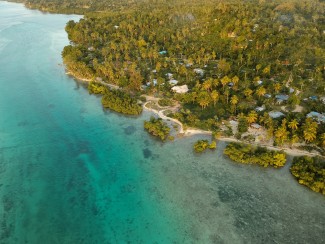|
|
|
|
The least developed countries (LDCs) are a group of 47 low-income countries highly vulnerable to a changing climate, as well as other economic and environmental shocks. Despite contributing the least to climate change, at less than 1% of global CO2 emissions, LDCs are demonstrating international leadership in enhancing their climate action in response to the challenges they face.
Recognising the gap in evidence on what works to deliver effective climate action, the LDC Group on Climate Change, which coordinates efforts under the UN Framework Convention on Climate Change (UNFCCC), commissioned a global review to build understanding of best practices, engaging over 600 experts and receiving 100 submissions of evidence.
The review was part of a broader deliberative process across LDCs in developing a long-term group 2050 Vision for achieving a climate-resilient future, launched in September 2019 at the UN Climate Action Summit. The vision aims for LDCs to be on climate-resilient development pathways by 2030 and deliver net-zero emissions by 2050.
Through launching this vision, the LDC Group demonstrated their enhanced ambition, and are calling on the global community to do the same at the 25th session of the Conference of the Parties (COP25) to the UNFCCC in December 2019.
Three key messages from the global review
First, building resilience to climate change requires long-term approaches on capacity building. Some of the most effective climate responses are nationally driven and owned and work to strengthen domestic institutions, structures and governance systems to manage and overcome climate risks over the longer term.
Second, coordinated and coherent action on a large scale is required to reach more people and larger geographies. For example, devolving climate governance, planning and financing from national to subnational levels can improve reach across countries to the local level. Bringing actors together, including governments, the private sector and civil society, also can ensure climate responses complement rather than duplicate each other. Coherence in actions also ensures that responses on global commitments including the Sustainable Development Goals, Paris Agreement, Sendai Framework for Disaster Risk Reduction and the Aichi Biodiversity Targets are aligned for efficiency and effectiveness.
Third, a socially just and inclusive approach is vital for reducing long-term vulnerability. Promoting equal opportunities for women and men to access economic resources, capacity building and gender-relevant technology is essential to building the resilience of both women and men. Similarly, taking an inclusive approach through investing in local organisations and businesses to better manage climate risk is crucial for building resilience at the local level. Achieving this requires a participatory approach involving meaningful engagement of local actors in the design and implementation of initiatives, integrating both local and technical knowledge to ensure climate responses are context specific and relevant.
Lessons from nationally determined contributions
All 47 LDCs have developed and submitted national climate plans known as nationally determined contributions (NDCs), outlining the actions, policies and measures they will take to overcome climate change and achieve the goals of the Paris Agreement.
Our review of these plans noted the leadership of LDCs in developing such plans and recognised the opportunity to strengthen them further in the following three areas.
First, move towards long-term national strategies. Several LDC NDCs are short-medium term. As noted, building resilience to climate change takes time, therefore NDCs should be embedded into longer-term strategies to 2050 or more. The recently launched LDC Group 2050 Vision aims to assist LDCs in planning for the longer term towards achieving a climate resilient future.
Second, improve coverage of adaptation measures by bringing in sectors and subsectors that are currently missing, including social protection, health, education and infrastructure. These vulnerable sectors are missing in many NDCs. By bringing in all relevant actors and departments through a whole-of-government and whole-of-society approach, this can enhance cross-coordination and incorporation of all vulnerable sectors to climate change.
Third, outline how NDCs will be implemented through strategic delivery mechanisms. Delivery mechanisms are structures and systems in place that support implementation of NDCs and climate plans. Several NDCs lack information on how plans will be delivered and the financial requirements for implementation. Presenting the country’s specific financing, capacity and technology needs, and outlining the channels for delivery, building on existing structures in country, will help clarify where support is needed, helping the international community to better target their resources.
Examples of delivery mechanisms
Delivery mechanisms can be public or private. They can be used to support the building of climate-resilient people, economies or ecosystems, or a mixture of all three.
An example of a public delivery mechanism is working with existing national social protection systems to build climate resilient people. These systems already target the most vulnerable in society including the poorest, the elderly and children through public works, employment guarantee schemes, pensions and school feeding programmes. Integrating climate risk management into the instruments of existing national social protection systems has the potential to support the most vulnerable populations to overcome the climate crisis.
Another example is working with local authorities and local communities to create integrated management approaches to restore damaged ecosystems. Given an ecosystem often crosses district boundaries, shared governance arrangements are required between local authorities and local communities to support effective management of ecosystems spanning several jurisdictions and territories. Since an ecosystem also encompasses the forestry, water, agroecology and fishery sectors, an integrated approach across actors and departments working in these areas is required to better address climate risks under the understanding of the wider interconnected nature of a shared ecosystem.
Working with small- and medium-sized enterprises to develop climate-resilient value chains is an example of a private delivery mechanism. Through integrating climate resilience into the value chain, from production to processing to marketing of products, this helps ensure small businesses continue to thrive and overcome associated climate impacts, as well as open new markets for climate-resilient products. Innovative delivery mechanisms, including through working with banks, offer opportunities for the channelling of support to local businesses, using new cashless services including mobile money to invest in climate action and reach scale, including to remote, rural areas.
Planning ahead
The lessons learned from these studies has helped inform the LDC Initiative for Effective Adaptation and Resilience (LIFE-AR), which supports LDC governments on planning and implementing their climate adaptation and resilience efforts in country.
Under this initiative, LDC countries aim to use a coordinated approach to develop national long-term climate strategies aligning with the LDC Group 2050 Vision. These strategies will strengthen their NDCs, with clearer channels for delivery, including through public and private mechanisms that reach the local level and the most vulnerable communities, working to build climate resilient people, economies and ecosystems.
------
Sarah McIvor and Sejal Patel are climate change policy researchers at the International Institute for Environment and Development (IIED).
If you would like to reuse any material published here, please let us know by sending an email to EIF Communications: eifcommunications@wto.org.



